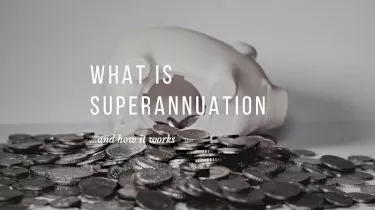Retirement
What is Superannuation and How Does It Work
People mostly turn to pension plans when thinking about financial security after retirement, but let’s face it, relying on pension alone is barely enough to live comfortably.
This is where the Superannuation system comes in.
What is Superannuation and How Does It Work
People mostly turn to pension plans when thinking about financial security after retirement, but let’s face it, relying on pension alone is barely enough to live comfortably.
This is where the Superannuation system comes in.

What is Superannuation
The Superannuation system or “super” is a tax-effective retirement saving scheme typically handled by professionally managed fund. It is basically a retirement income plan in which employers are required to separately contribute a minimum amount equal to 9.5 per cent of their employee’s wage on top of the basic pay.
That means employers will not use any portion of their employee’s pre-tax wage for the super contribution unless the employee agrees to do so.
Employees don’t need to do much other than choose from a set of super funds pre-selected by the company— at least if they are content with the guaranteed contributions from their employer.
No matter how convenient it seems, however, a basic knowledge on how super works would help you avoid complications and maximise retirement savings. Here are some of the things you have to know about super:

What's the Eligibility
The only thing a person needs to qualify for a super is to be employed in Australia. Once employed, employers are required by law to give guaranteed contributions for your super account, except for those whose employers come from Norfolk Island because they have a different rate for contribution.
Fund management
The company is required to provide a set of investment choices for their offered super funds. More often than not, companies hire professional fund managers to do this for their employees (for a fee), so try to compare fund management fees with those from other companies to determine if they are charging too much.
How to Make Superannuation Contributions
Unlike the 401(k) in the US, Australia’s super already has a required contribution rate set in place for employers, which is equal to 9.5 per cent of the wage and is contributed separately. This means that an employer is required to give a guaranteed super contribution of $47.5 for an employee whose wage is $500.
The employer-guaranteed contribution is the most basic type of super contribution and is, by no means, a limit. Those who wish to bulk up their retirement fund may still add to their super through the following ways:
Salary Sacrifice
Salary sacrifice basically means an employee would insert some of their own money from their wage to their super. Those who wish to do this must discuss and arrange the terms with their employer because it could go four ways:
- The salary sacrifice could be contributed on top of the guaranteed contribution;
- The deducted amount could be inserted as part of the percentage for the guaranteed contribution, which would lessen the rate of guaranteed contribution. (i.e., the employer will only be required to contribute 3.5 per cent if an employee sacrifices a portion of their wage amounting to 6 per cent of the computed guaranteed contribution);
- The salary-sacrifice could come from giving up some fringe benefits offered by the company;
- If you sacrifice 9.5 per cent of your salary, your employer would no longer be required to give a guaranteed contribution since the minimum contribution is already being met.
Employees and employers may enter into an agreement with regard to the salary sacrifice, but it is up to both parties to ensure the terms are met, especially those who have only formed a verbal agreement.
Super Co-Contributions
Super co-contributions is a matching contribution coming from the government, but are only applicable to individuals within the lower income threshold.
As of fiscal year 2017-18, the government has set aside up to $500 for individuals who earn between $36,813 and $51,813, but the match contribution and lower income threshold change every fiscal year. Lower income individuals must also:
- not have a total super balance of $1.6 mil by the end of the previous fiscal year; and,
- not have exceeded their post-tax contribution cap in the current fiscal year.
The super co-contribution is computed and given sent to eligible individuals’ super automatically once they file a tax return with their Tax File Number (TFN).
Contributions, Limits, and Exceptions
There is actually no contribution limit for the super but a contribution cap for the total annual pre-tax contribution exists. The cap does not necessarily mean an employee may not add funds to their super, rather, it is the amount that guarantees that only the maximum income tax rate of 15 per cent will be applied to the super. Any amount in excess of the contribution cap means extra taxes to be paid, and these are usually bigger.
Contribution caps also depend on the age of the employee. The 2016-17 approved caps are $30,000 for people under 50 years old and $35,000 for those turning 50 (and older) fiscal year 2016-17.
There is an exception to the cap, but only if certain conditions are met.
Employees are allowed to contribute past the contribution cap if their super’s balance has not reached $500,000 by the end of the previous fiscal year and they have unused pre-tax contributions.
For example, 30- year-old employee A has a total super balance of $490,000 and a maxed out contribution cap by the end of the previous fiscal year but has only contributed $26,000 annually for the previous 3 fiscal years. He will then be eligible to contribute up to $12,000 more than the cap in the next fiscal year. He will not be eligible for the exception the following year because he will have reached a total superannuation balance of $500,000.
Withdrawals
It is generally inadvisable to withdraw money from your super fund early but it is allowable in some cases, such as serious medical conditions, severe financial hardship, and withdrawals on compassionate grounds.
It is also possible to close the super account if the total balance is $200 or less.
Taxation
Concessional contributions, or super contributions submitted before tax deductions are made, are generally taxed at 15 per cent but exceeding the contribution cap during the fiscal year could mean getting taxed at the highest marginal tax rate (up to 49 per cent).
If contributions are within the cap, however, taxes applied to withdrawals depend on whether the contribution comes from the taxable or tax-free component.
Contributions withdrawn from tax-free sources (contributions after tax deductions and those that the fund manager has paid 15 per cent tax on) can be withdrawn without getting taxed and at any age. Concessional contributions, or those that have been contributed pre-tax deductions, however, will be taxed depending on your current age, the preservation age, and whether you will receive it as a lump sum or an income stream.
How can I Choose a Super Fund?
There are hundreds of existing funds at any given time and selecting from a large pool can make choosing a super fund difficult. However, there are ways to make the selection process simple.
The quickest way to choose a super is to prepare a retirement plan as early as possible. Creating a retirement plan may help you identify your objectives and highlight what you will need from a super fund in order to achieve your goals.
Consider the aspects below when comparing funds.
Investment Options
Different funds offer different investment options both in number and type. Compare the types of investment available to you and determine if they match your objectives, risk appetite and asset preferences.
Fees
Different funds have different fee structures, and high fees can affect the growth of the money in your fund. Before investing your money, ask about the costs of keeping the fund. Ask for details about the fund’s charges such as which services are paid and free and how much and how often you will be charged.
Performance
Historical performance isn’t an indication of future performance. However, knowing how well the fund performed in the past may clue you in on its stability. Choose a fund that has performed well over the medium and long term.
Services
Ask about the services that the fund manager offers and determine how important these services are for you. For instance, one fund may simply mail an annual statement, while another includes pertinent data to explain your fund’s performance.
Features (inclusions and extras)
Check what features are included in the fund and whether such features are bulking up the cost of maintaining the fund. If you require certain features, such as insurance coverage within super, but the fund you’re considering doesn’t automatically have it, inquire whether it’s possible to include and how much it would cost.
Another way is to visit super comparison sites so that you can compare important aspects of your shortlisted funds side by side.
What Will Happen to my Super Fund?
Your superannuation investment works much like most managed funds. Once you have chosen from among a variety of fund managers and super investment options, your employer is required to turn over salary guarantee contributions regularly. You may also make salary sacrifice and voluntary non-concessional contributions to increase your fund balance.
The fund manager, in turn, invests your money according to your chosen product and strategy. This is repeated until you cease gainful employment upon retirement.
You may start receiving pension from super once you satisfy a condition of release. Depending on your age, however, your income may be subject to taxes. Income from superannuation will only gain a tax-free status for pensioners aged 60 and over.
When Can I Access my Super Fund?
Accessing your super isn’t allowed until you satisfy the conditions of release that are set in the Superannuation Industry (Supervision) Act 1993. Under normal circumstances, the prerequisite condition is reaching the superannuation preservation age, which ranges from 55 to 60, depending on your date of birth.
Preservation age can be considered as the superannuation withdrawal age as this signals whether you are eligible to commence a transition to retirement income stream or receive super benefits by retiring.
Below is the superannuation preservation age table for reference:
| Birthdate | Preservation age |
| Before 1 July 1960 | 55 |
| 1 July 1960 - 30 June 1961 | 56 |
| 1 July 1961 - 30 June 1962 | 57 |
| 1 July 1962 - 30 June 1963 | 58 |
| 1 July 1963 - 30 June 1964 | 59 |
| 1 July 1964 onwards | 60 |
Things to remember:
Super is compulsory for all employers but not all employers hire the same fund managers or choose the same super plans. This means employees who changed jobs may have more than one super fund to their name.
It is important to keep track of your super accounts and contributions to avoid extra taxes and to maximise earnings, so it is advisable for those with several super funds to combine them into one fund they prefer.
This information has been sourced from the Australian Taxation Office and ASIC.
Read more about superannuation advantages and disadvantages.
About the author

About the author


Superannuation
Industry leaders weigh in on concessional super tax as Budget confirms $55bn investment
Changes to the taxation of superannuation earnings and contributions have drawn mixed responses from financial and payroll sector leaders, as the Federal Budget confirms over $55 billion in ...Read more

Superannuation
Call for indexation on super tax cap as $3m threshold draws criticism
A senior executive in the superannuation technology sector has criticised the Federal Government for failing to index the proposed $3 million superannuation tax cap, arguing the measure will unfairly ...Read more

Superannuation
Rest members back calls for fairer superannuation rules ahead of Federal Budget
Rest has called on the Federal Government to implement superannuation reforms aimed at improving fairness across the system, after member survey results showed strong support for a range of proposed ...Read more

Superannuation
Rest welcomes progress on ‘Payday Super’ reform
Rest, one of Australia’s largest profit-to-member superannuation funds, has welcomed the Australian Government’s release of draft ‘Payday Super’ legislation, which aims to align Superannuation ...Read more

Superannuation
SuperAPI and Humanforce partner to improve superannuation compliance for one million Australians
Superannuation engagement platform SuperAPI has partnered with human capital management provider Humanforce to streamline payroll and superannuation contributions for more than one million Australian ...Read more

Superannuation
Rest super fund reports 11.19 per cent return for 2024
Rest superannuation fund delivered an 11.19 per cent return in its MySuper Growth investment option for calendar year 2024, marking two consecutive years of positive returns. Read more

Superannuation
Actuaries propose three-tier superannuation tax reform
The Actuaries Institute has outlined major reforms to Australia's $4.1 trillion superannuation system, proposing uniform tax rates and new levies on high retirement withdrawals. Read more

Superannuation
Survey reveals Australians' reliance on superannuation for retirement
A new survey by AustralianSuper has found that only 32% of Australians believe they could save for retirement without compulsory superannuation. Read more

Superannuation
Industry leaders weigh in on concessional super tax as Budget confirms $55bn investment
Changes to the taxation of superannuation earnings and contributions have drawn mixed responses from financial and payroll sector leaders, as the Federal Budget confirms over $55 billion in ...Read more

Superannuation
Call for indexation on super tax cap as $3m threshold draws criticism
A senior executive in the superannuation technology sector has criticised the Federal Government for failing to index the proposed $3 million superannuation tax cap, arguing the measure will unfairly ...Read more

Superannuation
Rest members back calls for fairer superannuation rules ahead of Federal Budget
Rest has called on the Federal Government to implement superannuation reforms aimed at improving fairness across the system, after member survey results showed strong support for a range of proposed ...Read more

Superannuation
Rest welcomes progress on ‘Payday Super’ reform
Rest, one of Australia’s largest profit-to-member superannuation funds, has welcomed the Australian Government’s release of draft ‘Payday Super’ legislation, which aims to align Superannuation ...Read more

Superannuation
SuperAPI and Humanforce partner to improve superannuation compliance for one million Australians
Superannuation engagement platform SuperAPI has partnered with human capital management provider Humanforce to streamline payroll and superannuation contributions for more than one million Australian ...Read more

Superannuation
Rest super fund reports 11.19 per cent return for 2024
Rest superannuation fund delivered an 11.19 per cent return in its MySuper Growth investment option for calendar year 2024, marking two consecutive years of positive returns. Read more

Superannuation
Actuaries propose three-tier superannuation tax reform
The Actuaries Institute has outlined major reforms to Australia's $4.1 trillion superannuation system, proposing uniform tax rates and new levies on high retirement withdrawals. Read more

Superannuation
Survey reveals Australians' reliance on superannuation for retirement
A new survey by AustralianSuper has found that only 32% of Australians believe they could save for retirement without compulsory superannuation. Read more








